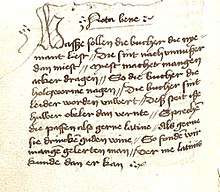Nota bene
Nota bene (/ˈnoʊtə ˈbɛneɪ/, /ˈnoʊtə ˈbɛni/ or /ˈnoʊtə ˈbiːni/; plural form notate bene) is a Latin phrase[1] which first appeared in English writing c. 1711.[2][3][4] Often abbreviated as NB, n.b., or with the ligature , the phrase is Latin for "note well" and comes from the Latin roots notāre ("to note") and bene ("well").[1] It is in the singular imperative mood, instructing one individual to note well the matter at hand, i.e., to take notice of or pay special attention to it. In Modern English, it is used, particularly in legal papers,[5] to draw the attention of the reader to a certain (side) aspect or detail of the subject being addressed. While NB is also often used in academic writing, note is a common substitute.


The markings used to draw readers' attention in medieval manuscripts are also called nota bene marks. The common medieval markings do not, however, include the abbreviation NB. The usual medieval equivalents are anagrams from the four letters in the word nota, the abbreviation DM from dignum memoria ("worth remembering"), or a symbol of a little hand (☞), called a manicule or index, with the index finger pointing towards the beginning of the significant passage.[6]
See also
| Look up nota bene, NB, N.B., nb, n.b., nota, D.M., DM, or manicule in Wiktionary, the free dictionary. |
- Annotation
- Footnote
- List of Latin abbreviations
- List of Latin phrases
- List of legal Latin terms
- Obiter dictum
- Postscript
- Quod vide
References
- "nota bene". Collins English Dictionary - Complete & Unabridged 11th Edition. CollinsDictionary.com. Retrieved 2012-10-22.
- Addison, Joseph (1891). The Works of Joseph Addison. W. W. Gibbings. p. 283.
- Addison, Joseph (2004). "No. 102 Wednesday, June 27, 1711". Project Gutenberg.
- Harper, Douglas. "nota bene". Online Etymology Dictionary. Retrieved 2016-03-02.
- "nota bene". HM Courts & Tribunals Service - Glossary of terms - Latin. Her Majesty's Courts Service, United Kingdom. Retrieved 2012-09-28.
- Raymond Clemens and Timothy Graham, Introduction to Manuscript Studies (Ithaca: Cornell University Press, 2007), p. 44.